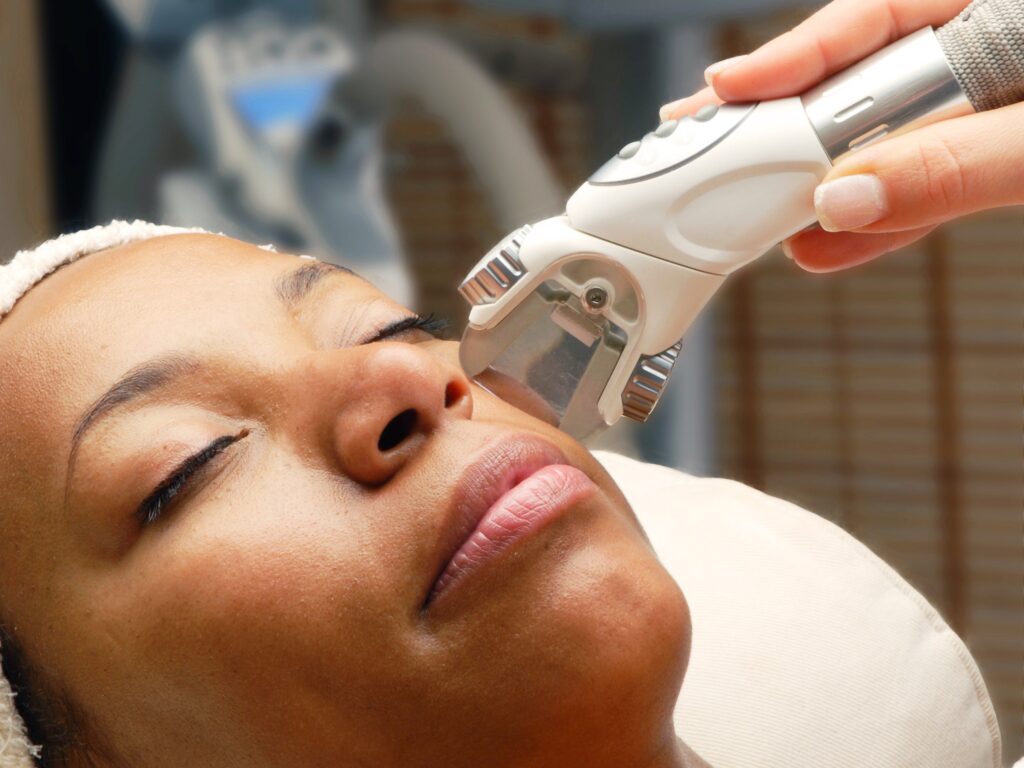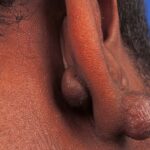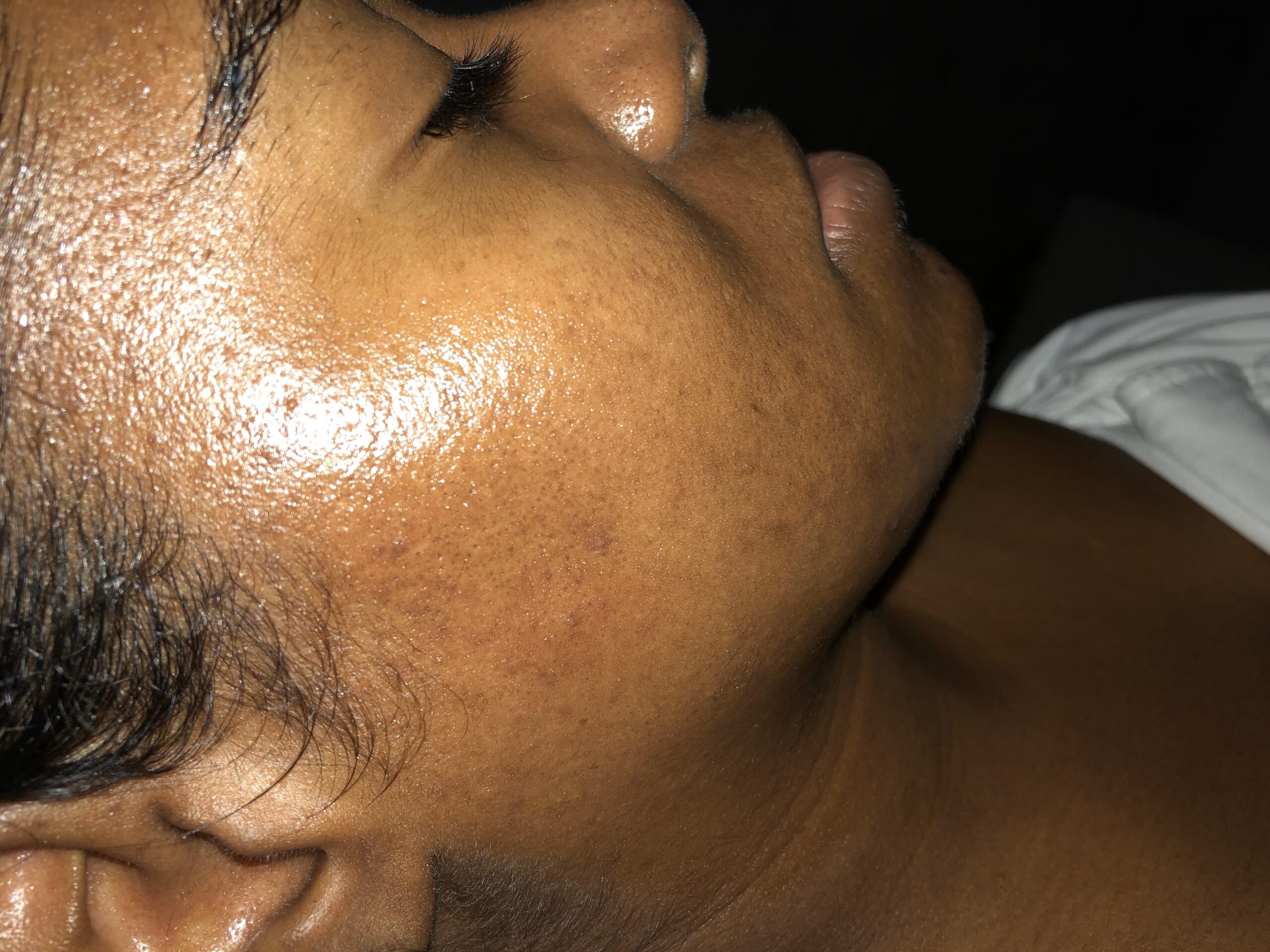Numerous dermatological conditions such as unrestrained hair growth, blood vessels and body arts among many others are treated by Laser therapy. Contrary to the opinions of many patients, laser is not a product of magic nor is it nearly as mystical as perceived. Lasers have short comings and limitations in terms of what they can achieve like any other modality especially in brown skin.
Laser as it is commonly called is in fact an abbreviation for Light Amplification by Stimulated Emission of Radiation, which simply translate to mean light is enhanced through the use of a gas, liquid, or solid medium to supply electrons and thereby stimulates the release of radiation (energy). The result which is the laser light then aims at a structure of the skin called a chromophore. Chromophores could mean melanin, an hemoglobin (oxygen carrier in blood), water, or body ink. This light splits into various wavelengths and specified wavelengths aims at selected chromophores. When one of these specified wavelength reaches its destination, it ignites a reaction which leads to heat production. The heat generated then destroys the chromophore. In a situation where facial hair growth is involved, the Nd:YAG laser (medium is neodymium-yttrium-aluminum-garnet) or the diode laser, identifies the melanin pigment in the hair, heats it up and annihilate it.
In cases of skin of color, the laser moves through the heavily pigmented melanin skin. Melanin present may absorb the laser, it gets fired up and resultantly damage the skin cells. There are situations where surrounding skin cells are destroyed alongside the chromophore also, this may be due to diffusion of the laser into the surroundings of the chromophore. Laser is quite potent when the destruction of skin cells are concerned thereby inflicting several types of injuries to the skin, could be burns which produces blisters, resulting scars and discoloration. Brown skin is more predisposed to side effects from the procedure due to increased melanin concentration. Therefore, laser therapy is best carried out by an experienced physician in this field and very well familiar with the brown skin. Lasers that poses less risks have been developed; these produce less damaging heat (long pulse lasers), better cooling methods are employed also such as cryogen spray, sapphire cooled tip, or cold air flow. These newly developed ones are more suitable for rich complexions. Suitability is further ensured through undergoing test spots; a procedure where small areas of skin is exposed to the laser to determine possible reaction from your skin.
Lasers
Several types of laser exist and each with its peculiarities, therefore it is imperative you master the ones best suited for you and the procedure of choice. Your dermatologist is in the best position to decide which laser is most appropriate for you. On several occasions, hair removal in a brown skin is best achieved with the use of the long pulse diode and long-pulse Nd:YAG lasers; the removal of tattoos is often with the Q-switched Nd:Yag laser; for skin discoloration and blood vessels, the long pulse Nd: YAG, Pulse Dye or ILP lasers are used; in cases of wrinkles and acne scars, the non-ablative ILP lasers. Below are the highlights of most common types of lasers and their uses.
| TYPES | EXAMPLE | USES | COMPARTIBLE SKIN TYPE |
| Q-switched Nd:YAG(1064nm) | smartEpil | For removal of skin pigmentation, lentigines and tattoos | All skin types |
| Long pulse Nd:YAG | smartEpil | For laser assisted hair removal, also for vascular lesions | All skin types |
| Long pulse Diode (800nm-810nm) | Light sheer | For laser assisted hair removal | All skin types |
| Intense Pulsed Light Quantum (IPL) | Quantum | For red and brown pigmentation, blood vessels, skin texture, facial lines, acne and scarring | All skin types |
Laser-assisted Hair Removal
Unwanted body and facial hair have been the nightmare of many women for too long, to say the least, it is borderline embarrassing. Laser-assisted hair removal would prove to be the long-awaited solution to your facial troubles, plucking, waxing and of course the long grueling process of electrolysis. The modern discoveries mean that lasers can be used to permanently eradicate not just facial hair, but also the famous axillary hair, bikini line, and other desired areas of the body. Please note this-to control hair growth, repeated laser treatments are indicated. It often takes about 4-6 laser treatments because hair can only be removed during its growth cycle. Considering the fact that all hairs are not in the same phase of the cycle, numerous appointments for treatments may be needed for maximal outcomes. Following about 4 or 5 treatment sessions, most clients discover between 50%-85% reduction in hair.
Long pulse diode and long-pulse Nd: YAG lasers among others are preferred lasers for laser-assisted hair removal in brown skin. According to a study carried out, it was reported that greater than 50% reduction of facial hair was observed after 6 months of treatment with a long-pulsed Nd:YAG laser. Laser therapy can be safely described as quick and takes somewhere between a few minutes to an hour, it largely depends on the size of the area being treated. Rest assured, you will be able to resume your regular activities immediately after the treatment. It is advisable not to wear make-up or use any form of skincare products prior to the procedure. Going for a tan either before or after hair removal treatments is ill-advised. To maximize the effects of the treatments, there must be residual hair in the follicle for the laser light to aim at, which means you should avoid waxing, plucking, or shaving 3- 4 weeks before the procedure. The procedure is relatively painless as little or no pain has been reported by patients who have undergone these procedures. It is also imperative to protect your skin pre and post-procedure with sunscreen.
Treatment of Vascular Lesions (Blood Vessels)
Telangiectasia (spider veins) is a common phenomenon in slightly lighter dark skins, it is more apparent on the face and some parts of the body to include the conspicuous leg veins. All the earlier highlighted with port wine stains are commonly known as red birthmarks have all been treated with lasers. In cases of vascular lesions and vessels, the laser used here is also absorbed by the melanin present in brown skin which may lead to injuries of the skin thereby making it a delicate procedure. This setback has been solved by the use of vascular lasers with longer wavelengths (Nd:YAG laser), these are also used in place of sclerotherapy if deemed inappropriate. The procedure involves the penetration of the laser light, identifies and heats the blood vessel, thereby destroying it. The body subsequently re-absorbs the vessel, hence, the blood flow is redirected through other veins. Treatments last for about 20 – 60 minutes, expect a slight burning sensation.
For Asians, port-wine stains may be on top of your list of skin troubles. Do not worry, these have been treated with the use of flashlamp Pulse Dye Laser with varied results. In a study that focused on 107 Asian patients, it was reported that 23% of the subjects had at least 50% clearing of the port wine stain but 14% had offshoots that were hallmarked by abnormal skin pigmentation. The long-pulse Nd:YAG laser has been the go-to treatment of telangiectasias and small red leg veins in brown-skinned women. These treatments are mostly well tolerated even though abnormal skin pigmentation may be a potential offshoot.
Laser Removal of Tattoos
Getting your dream tattoo may have been quite rosy but taking it off isn’t nearly as smooth. Here is how it works; a tattoo is made by injecting ink into your skin with needles and hence a permanent part of your skin. Thankfully, Lasers can be used to get rid of tattoos, but even this method has its limitations. Some inks are easier to get rid of while some others aren’t. Black pigment tends to absorb all laser light; this makes it the easiest to remove. Green on the other hand is the hardest to remove, in another category red and blue are removed more easily. In summary, having a tattoo removed can be expensive and time-consuming.
The most appropriate laser for tattoo removal is arguably the Q-switched Nd: YAG for people of color. However, lasers such as Q-switched alexandrite and Q-switched ruby have been used also, but with increased risk of light or dark marks and often time, scarring. The process of tattoo removal may demand up to 8-12 treatment sessions which is spread across 6 to 8 weeks. The laser pinpoints the tattoo pigment breaks it down and the body is left to reabsorb and subsequently excrete it. With each session of therapy, the laser is allowed to fragment more ink particles and penetrate your skin better. It is worthy to note that most tattoos do not get removed completely even with laser treatment.
Lasers for Pigmented Lesions
Following up on the earlier stated, persons with rich complexion have higher melanin levels present in their skin, this is responsible for the complications shown as melanin are highly reactive. It ultimately increases the pigmentation of the skin in the forms of disorder such as post-inflammatory hyperpigmentation, melasma, lentigines, and nevus of Ota. The named disorders have been successfully treated with lasers with varied success.
Asians have melasma as one of the notorious skin conditions among them, African Americans and Latinos have undergone therapy sessions using the Q-switched ruby and the erbium:YAG lasers, however, unappealing discolorations of the skin marred the results. Liver spots or sun spots, known as lentigines are mostly seen among Asians and Latinas, it yields to the Q-switched alexandrite, Q-switched ruby, and the frequency-doubled Q-switched Nd:YAG lasers following one or two treatment sessions. It may start with whitening of the skin and then proceed to scabs mostly at the site of treatment. Post-inflammatory hyperpigmentation tends to occur in about 1% to 50% of Asian patients according to reports.
A dark patch is often seen in the temple area; known as ‘Nevus of Ota’ is very rampant among Asians, but may be found in African Americans also. Several lasers have been used to treat this condition, these include; ruby, the Q-switched lasers, alexandrite, and 1064-nm Nd:YAG with varied results. Routinely, 3-4 treatment sessions spread over 3-4 months are required to notice improvements.
Offshoots include hypopigmentation, post-inflammatory hyperpigmentation, scarring, and rough areas on the skin. A research compared the Q-switched alexandrite with the Q-switched Nd:YAG for the treatment of nevus of Ota among Asians, it was realized that most subjects tolerated the Q-switched alexandrite treatment, however, the Q-switched Nd:YAG gave better results. The Q-switched Nd:YAG is more appropriate for the treatment of Nevus of Ota among African Americans.
Keloidal and Hypertrophic Scars
Please note, it is imperative that you do not treat a keloidal or hypertrophic scar with the carbon-dioxide laser, which is close to surgical excision, this is due to the risk of keloid regrowth. The use of pulsed dye laser in the treatment of keloids and hypertrophic scars has known a measure of success, it works by targeting the blood vessels in the scar, damages them, and thereby reduces the blood supply, in turn, reduces the scar. The pulse dye laser however does not completely remove the scar but it is able to reduce redness and shrinks it. It ultimately leaves the scar softer and with reduced itching and pain. At times, the laser is used in conjunction with steroids injections to flatten the scar.
Intense Pulsed Light
The intense Pulsed Light (IPL) procedure is also called photorejuvenation, this is a new laser technology that can be used to treat blood vessels, fine lines, lentigines, acne scars, wrinkles, and large pores. This procedure engages high-intensity pulses of broadband light and delivers it to the skin. This procedure is relatively mild in that it does not damage the skin surface hence, it is very appropriate for dark skin. The light penetrates the skin and leaves the upper layers unhurt. The IPL generates thermal actions and thus encourages increased production of collagen which in turn reduces scars and reverses aging outlook.
30-45 minutes is the estimated time for treatment and should be repeated at monthly intervals. Usually, five treatment sessions are required to get the desired result. Slight discomfort may be felt during treatment especially in facial treatments, this can be characterized by a burning or stinging sensation. All routine activities would be resumed after the treatment is complete, hence, it is advisable not to wear cosmetics nor tan before and after treatment on designated days of treatments.
In summary,
Going for laser treatment is a choice that requires adequate information for you to weigh your options before a decision on which and if you must. It becomes even more imperative for rich complexion individuals due to a reasonably higher risk of varied offshoots following the chosen laser treatment option. Ensure you get a certified practitioner in laser treatment with adequate experience with skin of color. Be ready to discuss all skin issues that may arise with your doctor also and keep the financial implications in mind as you make a decision on laser therapy.



